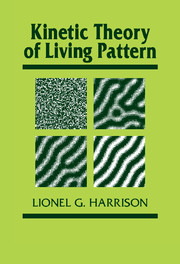Book contents
- Frontmatter
- Contents
- Preface
- Part I Macroscopics without mathematics
- Part II Pattern-forming processes
- 5 The making and breaking of symmetry
- 6 Matters needing mathematics: an introduction
- 7 Kinetic models for stable pattern: an introduction
- Part III Bringing experiment and theory together
- References
- Index
5 - The making and breaking of symmetry
Published online by Cambridge University Press: 22 September 2009
- Frontmatter
- Contents
- Preface
- Part I Macroscopics without mathematics
- Part II Pattern-forming processes
- 5 The making and breaking of symmetry
- 6 Matters needing mathematics: an introduction
- 7 Kinetic models for stable pattern: an introduction
- Part III Bringing experiment and theory together
- References
- Index
Summary
In a review seeking to draw the attention of physical chemists to morphogenesis (Harrison, 1981) I wrote: “Morphogenesis is the creation of a complicated shape out of a simpler one by chemical processes in living organisms. To the physical scientist, the essence of it is symmetry-breaking.” Almost simultaneously, Meinhardt (1982) wrote: “In most biological cases, pattern formation does not involve symmetry breaking (although the proposed mechanism can perform this). …” Here we have an apparent contradiction between two people who usually see eye to eye about the general strategy of the explanations of morphogenesis. Each of us then proceeded to mention antecedents such that the precept “asymmetry begets asymmetry” would not be violated; but they were different in the two accounts. From mine: “Natural disturbances, which are continually present everywhere, contain adequate asymmetry to serve as antecedent for any shape, however complex. But how do living organisms go about making a rather precise selection of what parts of the available asymmetry to amplify?” From Meinhardt's: “The asymmetric organism forms an asymmetric egg and the orientation of the developing organism is therefore predictable.” In the first quotation, I stressed the inheritance of a selection mechanism to extract order out of chaos; Meinhardt emphasized the direct inheritance of asymmetry. Both are aspects of macroscopics, and the contradiction between the two attitudes is only apparent.
- Type
- Chapter
- Information
- Kinetic Theory of Living Pattern , pp. 145 - 172Publisher: Cambridge University PressPrint publication year: 1993



